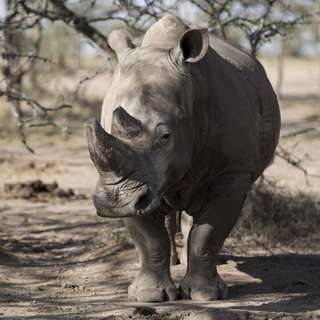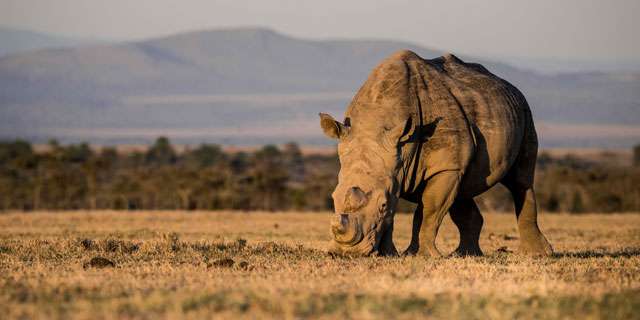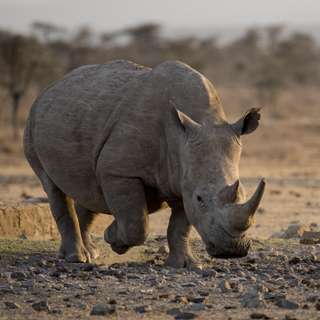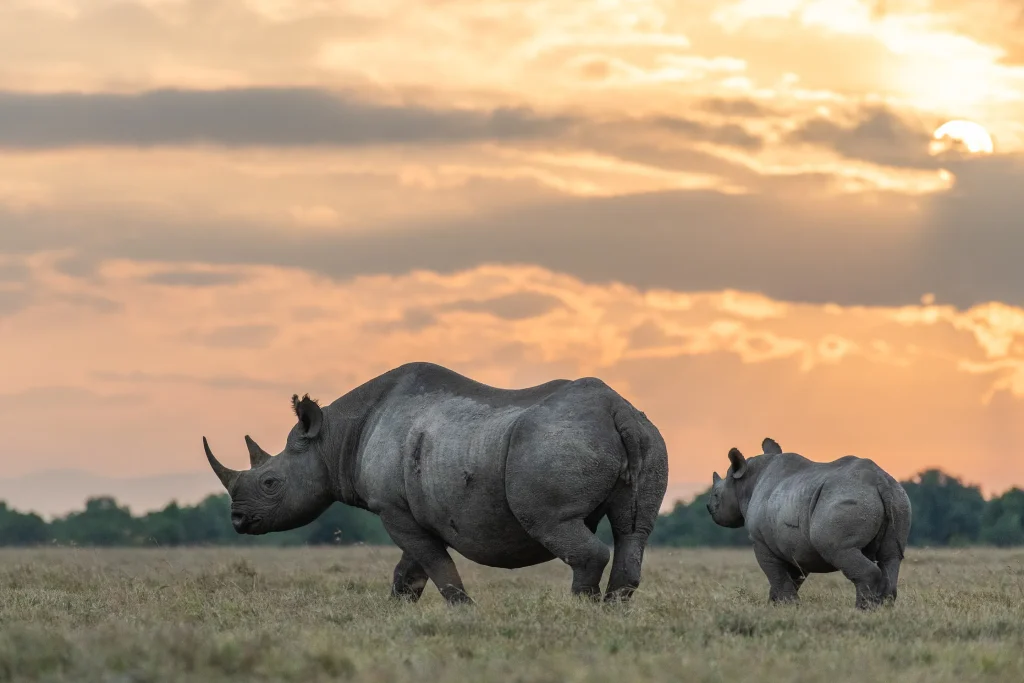RHINOS
Ol Pejeta is home to the last two remaining northern white rhinos, and a sanctuary for over 165 critically Endangered black rhinos. The Conservancy employs highly trained rhino protection squads, partners with international veterinary experts and ensures data is gathered regularly on each individual animal. Steps like these ensure we remain a role model for rhino conservation in East and Central Africa.
NORTHERN WHITE RHINOS
EXTINCT IN THE WILD
The northern white rhino (Ceratotherium simum cottoni) is a subspecies of white rhino, which used to range over parts of Uganda, Chad, Sudan, the Central African Republic, and the Democratic Republic of the Congo. Years of widespread poaching and civil war in their home range have devastated northern white rhino populations, and they are now considered to be extinct in the wild. Only two remain, both on Ol Pejeta Conservancy.
THE STORY OF THE NORTHERN WHITE RHINOS
On December 20th, 2009, four of the world’s last remaining seven northern white rhinos arrived at Ol Pejeta. Najin, Fatu, Sudan and Suni had been living in Dvur Kralove Zoo in the Czech Republic. All previous breeding attempts in the Zoo had been futile, and the hope was that the climate and rich grasslands of Ol Pejeta, a native habitat for the animals, would provide them with more favourable breeding conditions.
SAFEGUARDING 24/7
To keep the northern white rhinos safe and in good health, Ol Pejeta dedicated 24hr armed security, a 700-acre enclosure, and a nutritious diet supplemented with fresh vegetables. Expectations were raised when Suni was seen mating with Najin in 2012, but as the gestation period of 16 months wore on, it was clear that Najin was not pregnant. With so few northern whites remaining, it was decided that a southern white male would be introduced to Fatu and Najin in the hope of producing offspring that would at least preserve some of the northern white genes. Again, this proved unsuccessful.
In October 2014, we were devastated with the loss of Suni, who died of natural causes in his enclosure. His death left Sudan as the only northern white male in the world capable of breeding. In early 2015, checks by vets from the Czech Republic dealt us another blow – neither of the females is capable of natural reproduction, and Sudan’s sperm count was disappointingly low (but not surprising given his age). In July 2015, Dvur Kralove Zoo in the Czech Republic lost Nabire, and in November 2015, San Diego Zoo lost Nola – leaving just three northern white rhino left on the planet.
On the 19th of March, 2018, Sudan died. He had been suffering from age-related health issues and from a series of infections. Once his condition worsened significantly and he was unable to stand up and evidently, suffered a great deal, the decision to euthanise him was made by his veterinary team.
TELL ME SOMETHING GOOD
The vet checks did conclude one last ray of hope – that artificially assisted reproduction was a possibility. The future of this subspecies now lies in the development of in vitro fertilisation techniques and stem cell technology, costly and complicated procedures that have never before been attempted in rhinos.


SOUTHERN WHITE RHINOS
Back from the Brink
The southern white rhino (Ceratotherium simum) is listed as near threatened by the International Union for Conservation of Nature (IUCN), and decreasing in number. According to the IUCN, this subspecies was on the brink of extinction by the end of the 19th century – having been reduced to just one small population of approximately 20-50 animals in South Africa. However, in one of the most successful collective conservation efforts of the century, there are now thriving populations in 12 countries in east and southern Africa – totalling around 16,000 individuals. However, the population of white rhinos has decreased rapidly in the last four years, from over 18,000 in 2018 to 16,000 today.
60K for a Kilo of Keratin?
While their numbers are far more stable than their black rhino cousins (estimated at just over 5,000), their horn is still just as sought after by criminal gangs. Demand comes from Asia and the Middle East, where rhino horn is considered to have medicinal properties and is used to make ornamental dagger handles. A kilo of rhino horn can fetch up to $60,000 on the black market, but ironically, it is just made of the same substance as human fingernails – keratin.
Did You Know?
Ol Pejeta conservancy has 44 southern whites. The first animals were introduced into Ol Pejeta in 2005. The presence of southern whites on the Conservancy was instrumental in enabling the translocated northern white rhino from Dvur Kralove Zoo to settle into African life when they arrived from the Czech Republic in 2009. Introducing the newcomers to random groups of wild southern whites in their natural environment evoked natural behaviour amongst them. Over time, the natural traits became more prominent – even motivating the northern white to begin mating.
There is actually no colour difference between white and black rhino. The name is said to have been a mistranslation of the Afrikaans word ‘weit’ meaning ‘wide’ – which refers to their square shaped lips used for grazing. This is the main distinction between white rhino and black, which have a hooked lip for browsing.
The southern white rhino is said to have the most complex social structure of all rhino subspecies (a group of rhinos is called a crash) and prefer open grass plains to thick bush enjoyed by black rhinos, making them easier to spot on safari.

BLACK RHINOS
Safeguarding the vulnerable
The black rhino (Diceros bicornis) is listed as Critically Endangered by the International Union for Conservation of Nature (IUCN). There are three subspecies of the black rhino, the eastern, the southern, and the southwestern, with Ol Pejeta being home to the eastern rhino subspecies.
According to IUCN, the black rhino population declined by a staggering 97.6% from 1960 to the 1990s, primarily as a result of poaching. In 1993, there were estimated to be just 2,300 black rhinos living in the wild, however thanks to conservation efforts across Kenya and southern Africa, populations have risen to over 6,000 as of 2022, an average upwards trend of 17% increase in population size over the past decade.
The populations of black rhinos have seen improvements in numbers across all three subspecies, with the largest increases in populations seen by the eastern black rhino over the past decade, averaging 30-40% population increases, here on Ol Pejeta we hope to keep this number rising; With a population of over 165 eastern black rhinos, we are the largest black rhino sanctuary in East and Central Africa.
Fancy selling your fingernails?
When early settlers came to eastern and southern Africa, rhinos were hunted for sport and meat. Today the demand comes from Asia and the Middle East, where rhino horn is falsely considered to have medicinal properties and is used to make ornamental dagger handles. A kilo of rhino horn can fetch up to US$60,000 on the black market. Ironically, rhino horn is just made of the same substance as human fingernails – keratin.
Tell me something good
On-going efforts by Ol Pejeta and similar organisations across Africa are slowly but surely helping black rhino populations increase. Ol Pejeta had 20 black rhinos in 1993, and successful breeding combined with tough anti-poaching operations allowed this number to flourish to over 165 today.
Did you know?
Adult male black rhinos weigh up to 1,350 kg and females up to 900 kg.
There are so many differences between the black rhino and the white rhino such as their size, however, there is actually no colour difference between them at all! in fact, the name ‘white rhino’ came from the Afrikaans word ‘wyd’, meaning wide in reference to the white rhino’s square shaped upper lip. It wasn’t until early English settlers arrived in Africa that the name changed to white due to a misinterpretation of the word. Other differences between the two species are the shape of their top lips; black rhinos have a V-shaped hooked lip to browse shrubs – and prefer thick bush habitat to their square-jawed, grazing counterparts. Black rhinos are also generally more solitary and shyer than the white rhino, and have a reputation for being more aggressive too!

